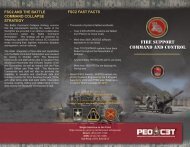2012 Annual Report to the Stakeholders - PEO C3T - U.S. Army
2012 Annual Report to the Stakeholders - PEO C3T - U.S. Army
2012 Annual Report to the Stakeholders - PEO C3T - U.S. Army
Create successful ePaper yourself
Turn your PDF publications into a flip-book with our unique Google optimized e-Paper software.
<strong>2012</strong> annual report <strong>to</strong> <strong>the</strong> stakeholders<br />
chAnging dAtA pRoductS<br />
<strong>to</strong> meet RequiRementS<br />
As it makes major upgrades<br />
<strong>to</strong> its tactical network,<br />
<strong>the</strong> <strong>Army</strong> is also revamping<br />
<strong>the</strong> way it maintains<br />
<strong>the</strong> digital “glue” that enables <strong>the</strong><br />
flow of information between different radios,<br />
mission command applications and<br />
o<strong>the</strong>r communications systems.<br />
<strong>PEO</strong> <strong>C3T</strong>’s Project Direc<strong>to</strong>r Tactical<br />
Network Initialization (PD TNI) has developed<br />
a user-friendly <strong>to</strong>ol, <strong>the</strong> Warfighter<br />
Initialization Tool (WIT), designed <strong>to</strong><br />
enhance <strong>the</strong> Signal officer’s ability <strong>to</strong> visualize,<br />
modify and manage <strong>the</strong> unit task<br />
organization and network architecture for<br />
systems that rely on <strong>the</strong> Command and<br />
Control Registry data. This collection of<br />
mission data, known as Data Products, is<br />
required <strong>to</strong> initialize networked systems,<br />
enabling end-<strong>to</strong>-end connectivity and interoperability<br />
across <strong>the</strong> tactical internet.<br />
Currently, once Data Products are built<br />
and delivered <strong>to</strong> a unit <strong>the</strong>y cannot be<br />
updated in real time.<br />
The WIT will change that, enabling<br />
Signal officers <strong>to</strong> update <strong>the</strong>ir “digital<br />
WIT<br />
functionality is<br />
part of <strong>the</strong> CS 13<br />
baseline<br />
phone book” <strong>to</strong> reflect what<br />
occurs in <strong>the</strong>ater, such as<br />
equipment or organizational<br />
changes like receiving a new<br />
communications technology or<br />
temporarily cross-attaching ano<strong>the</strong>r unit.<br />
Commanders will be able <strong>to</strong> take a more<br />
hands-on approach, defining and adapting<br />
<strong>the</strong>ir systems architecture based on<br />
<strong>the</strong>ir fight.<br />
“In <strong>the</strong> past we were never able <strong>to</strong><br />
manipulate <strong>the</strong> Data Product itself, so<br />
this is giving us that capability,” said Chief<br />
Warrant Officer 2 Mark Smith, a signal<br />
officer with <strong>the</strong> 2nd Brigade, 1st Armored<br />
Division (2/1 AD).<br />
The <strong>to</strong>ol will also provide senior commanders<br />
with a more accurate Common<br />
Operational Picture that provides a single<br />
display of relevant information <strong>to</strong> multiple<br />
commands.<br />
The WIT was integrated in<strong>to</strong> mission<br />
scenarios as a System Under Evaluation<br />
at <strong>the</strong> Network Integration Evaluation<br />
(NIE) 12.2, where it received positive<br />
feedback from Soldiers who used it <strong>to</strong><br />
update <strong>the</strong>ir Data Products during <strong>the</strong><br />
Caps<strong>to</strong>ne portion of <strong>the</strong> exercise.<br />
“There were times that I saw in real<br />
world deployments where you were attaching<br />
a company or a pla<strong>to</strong>on <strong>to</strong> ano<strong>the</strong>r<br />
element out <strong>the</strong>re – this allows you<br />
<strong>to</strong> do that without having <strong>to</strong> ei<strong>the</strong>r wait<br />
six months or fall in on equipment that<br />
may not have <strong>the</strong> same role name or<br />
IP address,” said Warrant Officer 1 Eric<br />
Bache, ano<strong>the</strong>r signal officer with 2/1 AD<br />
who used <strong>the</strong> WIT at NIE. “you’re able <strong>to</strong><br />
receive units and put <strong>the</strong>m in<strong>to</strong> your Data<br />
Product fairly seamlessly.”<br />
The WIT is considered an interim step<br />
<strong>to</strong> a long-term Data Products solution<br />
that will enable “dynamic initialization.” By<br />
creating common standards <strong>to</strong> simplify<br />
<strong>the</strong> data that governs initialization, PD<br />
TNI aims <strong>to</strong> make initializing tactical<br />
systems faster and cheaper. In this<br />
scenario, using tactical systems would<br />
be like logging in<strong>to</strong> an email account: The<br />
system au<strong>to</strong>matically recognizes you,<br />
updates your inbox and connects you<br />
seamlessly with o<strong>the</strong>r users.<br />
Without Data<br />
Products, troops<br />
would lack critical<br />
information<br />
<strong>to</strong> plan and<br />
coordinate <strong>the</strong><br />
battle. In response<br />
<strong>to</strong> operational<br />
needs, we have<br />
increased our<br />
output of Data<br />
Products, building<br />
and delivering<br />
<strong>the</strong>m faster while<br />
also streamlining<br />
how Soldiers will<br />
initialize systems<br />
in <strong>the</strong> future.<br />
Maj. Gen. N. Lee. S. Price<br />
<strong>PEO</strong> for <strong>PEO</strong> <strong>C3T</strong><br />
Program ExEcutivE officE command control communications-tactical // 21



